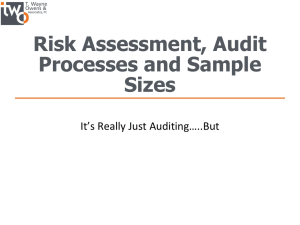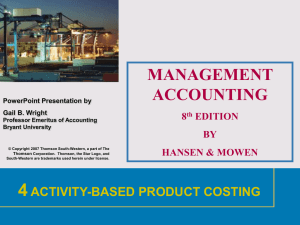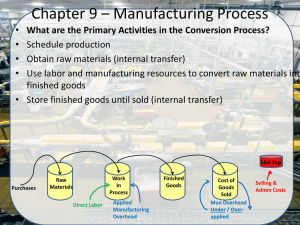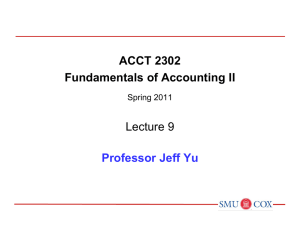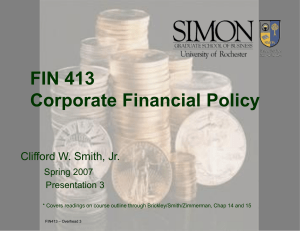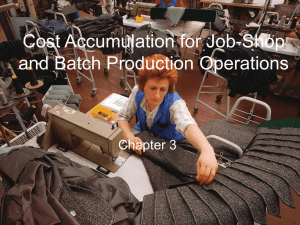CHAPTER 18
advertisement
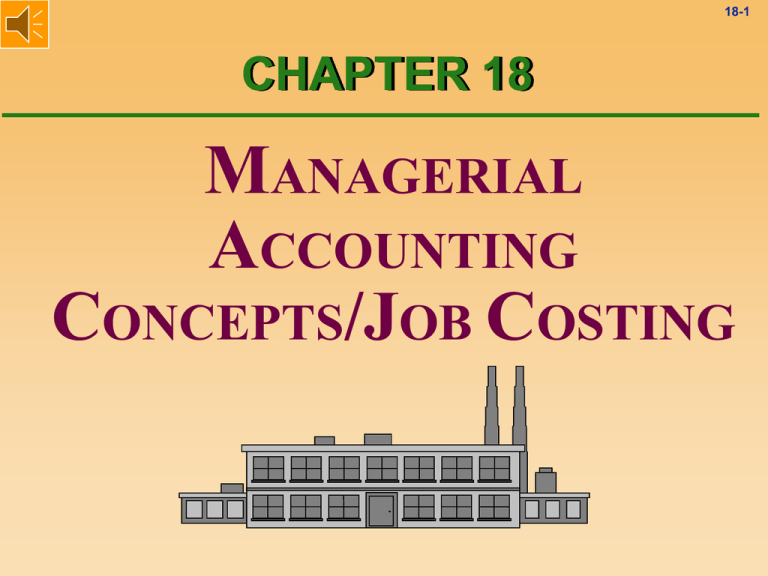
18-1 CHAPTER 18 MANAGERIAL ACCOUNTING CONCEPTS/JOB COSTING Compare Managerial and Financial Accounting 18-2 Financial accounting provides information for external use. Managerial accounting provides information for internal use. Creditors and investors Managers Compare Managerial and Financial Accounting Financial Accounting Uses historical data Presents summary data Complies with GAAP (Generally Accepted Accounting Principles) 18-3 Managerial Accounting May use estimates of future (e.g., budgeting) More detailed data Flexible format, cost/ benefit analysis determines proper level of information 18-4 Ethical Issues Competence Confidentiality Institute of Management Accountants Standards of Ethical Conduct Integrity Objectivity 18-5 Manufacturing Cost Concepts Cost is a financial measure of resources used or given up to achieve an objective. Product costs are the costs a company assigns to units produced. (i.e., costs which relate to or attach to the product) 18-6 Product Cost Components Direct Material Direct Labor Product Costs Manufacturing Overhead 18-7 Product Cost Components Direct Materials Materials that are clearly and easily traced to a particular product Example: Wood used to manufacture a high-quality dining room table 18-8 Product Cost Components Direct Labor Labor cost of employees working to convert materials into finished goods Labor cost clearly traceable to, or readily identifiable with, the finished product Example: Wages paid to carpenter 18-9 Product Cost Components Manufacturing Overhead All manufacturing costs except direct material and direct labor Manufacturing costs that cannot be traced directly to specific units produced Example: Indirect labor such as furniture designer 18-10 Product Cost Components Manufacturing Overhead - other examples - Indirect labor: Janitors, Supervisors, Materials storeroom personnel, Cost accountant - Indirect materials: Oil, Nails, Glue - Other indirect costs: – Repairs and maintenance on factory buildings and equipment – Payroll taxes and fringe benefits for manufacturing employees – Depreciation on factory buildings and equipment – Insurance and taxes on factory property and inventories – Utilities for factory buildings 18-11 Product Costs Why are product costs often called inventoriable costs? Because the costs remain in inventory until the product is sold, at which time they become an expense called cost of goods sold. 18-12 Period Costs • Nonmanufacturing costs which relate to or attach to the period • Can be classified as • Selling costs • Administrative costs Period costs are expensed in the period incurred. Period costs are never inventoried with the product. 18-13 Period Costs Selling Costs Costs incurred to obtain customer orders and to deliver finished goods to customers (e.g., advertising and shipping) Administrative Costs Nonmanufacturing costs of staff support and administrative functions (e.g., accounting, data processing, personnel, research and development) 18-14 Question The primary distinction between product and period costs is . . . a. Product costs are expensed in the period incurred. b. Product costs are directly traceable to product units. c. Product costs are inventoriable. d. Period costs are inventoriable. 18-15 Question The primary distinction between product and period costs is . . . a. Product costs are expensed in the period incurred. b. Product costs are directly traceable to product units. c. Product costs are inventoriable. c. d. Period costs are inventoriable. 18-16 Ways to Classify Costs 1 Product Costs 2 Direct Materials Direct Labor 3 4 Manufacturing Costs Either Manufacturing Overhead Period Costs Selling Administrative fixed or NonManufacturing Costs Variable Costs Financial Reporting by Manufacturing Companies Raw Materials Work in Process Manufacturing Inventory Classifications Finished Goods 18-17 Financial Reporting by Manufacturing Companies Raw Materials Materials waiting to be processed Work in Process Partially complete products Material to which some labor and/or overhead have been added Finished Goods Completed products for sale 18-18 18-19 Balance Sheet Presentation MERCHANDISER Current Assets Cash Receivables Prepaid Expenses Merchandise Inventory MANUFACTURER Current Assets Cash Receivables Prepaid Expenses Inventories Raw Materials Work in Process Finished Goods 18-20 Question What type of account is the manufacturing work in process account? a. Income statement expense account. b. Balance sheet inventory account. c. Temporary clearing account for direct material and direct labor. d. Holding account for manufacturing overhead and direct labor. 18-21 Question What type of account is the manufacturing work in process account? a. Income statement expense account. b. Balance sheet inventory account. c. Temporary clearing account for direct c. material and direct labor. d. Holding account for manufacturing overhead and direct labor. 18-22 Manufacturing Cost Flows Direct Material Direct Labor Manufacturing Overhead Work in Process Finished Goods Cost of Goods Sold 18-23 Cost of Goods Manufactured Cost of all goods completed during a period and transferred from work in process to finished goods 18-24 Cost of Goods Manufactured Cost of all goods completed during a period and transferred from work in process to finished goods + + = + – = Direct Materials Used Direct Labor Manufacturing Overhead Cost to Manufacture Beginning Work in Process Ending Work in Process Cost of Goods Manufactured 18-25 Cost of Goods Sold Cost of the items sold to customers during a period 18-26 Cost of Goods Sold Cost of the items sold to customers during a period + = – = Beginning Finished Goods Cost of Goods Manufactured Cost of Goods Available for Sale Ending Finished Goods Cost of Goods Sold 18-27 Income Statement Presentation – = – = Sales Cost of Goods Sold Gross Margin Operating Expenses Operating Income p. 688 18-28 Types of Cost Systems Process Costing Job Costing Used for production of small, identical, low-cost items Mass produced in automated continuous production process Costs cannot be directly traced to each unit of product 18-29 Types of Cost Systems Process Costing Job Costing Typical process cost applications: Petrochemical refinery Paint manufacturer Paper mill 18-30 Types of Cost Systems Process Costing Job Costing Used for production of large, unique, high-cost items Built to order rather than mass produced Many costs can be directly traced to each job 18-31 Types of Cost Systems Process Costing Job Costing Typical job order cost applications Custom furniture manufacturing Building construction Also used in service industry Hospitals Accounting and law firms 18-32 Job Order Costing Direct material THE JOB Direct labor 18-33 Job Order Costing Manufacturing Overhead (OH) Applied to each job based on activity causing the OH Direct material THE JOB Direct labor 18-34 Job Order Costing Manufacturing Overhead (OH) Applied to each job based on activity causing the OH Synonyms for “Applied” Overhead Assigned Distributed Allocated Absorbed 18-35 Job Order Costing I see some journal entries for job costing on the horizon! 18-36 Job Order Costing Typical Accounting Entries (pp. 690 - 693) To record purchase of materials Raw Materials Inventory Accounts Payable To record use of materials Work in Process Inventory Manufacturing Overhead Materials Inventory (Debit) (Credit) (Debit) (Debit) (Credit) 18-37 Job Order Costing Payroll Accounting Entry (Not discussed in text) To record payment to employees Payroll Summary Wages Payable Various Taxes Withheld (Debit) (Credit) (Credit) 18-38 Job Order Costing Typical Accounting Entries (pp. 690 - 693) To record labor costs Work in Process Inventory Manufacturing Overhead Payroll Summary (Debit) (Debit) (Credit) To apply overhead to jobs Work in Process Inventory Manufacturing Overhead (Debit) (Credit) 18-39 Job Order Costing Typical Accounting Entries (pp. 690 - 693) To record completion of jobs Finished Goods Inventory Work in Process Inventory (Debit) (Credit) 18-40 Job Order Costing Typical Accounting Entries (pp. 690 - 693) To record sales Accounts Receivable Sales (Debit) (Credit) To record cost of goods sold Cost of Goods Sold (Debit) Finished Goods Inventory (Credit) 18-41 Job Cost Flows Raw Materials Mfg. O/H WIP FG CGS 18-42 Job Cost Flows Raw Materials Material Purchases Mfg. Overhead Work in Process 18-43 Job Cost Flows Raw Materials Material Direct Purchases Material Mfg. Overhead Work in Process Direct Material 18-44 Job Cost Flows Raw Materials Material Direct Purchases Material Indirect Material Mfg. Overhead Actual Overhead Costs Work in Process Direct Material 18-45 Job Cost Flows Payroll Summary Incurred Mfg. Overhead Actual Overhead Costs Work in Process Direct Material 18-46 Job Cost Flows Payroll Summary Incurred Direct Labor Mfg. Overhead Actual Overhead Costs Work in Process Direct Material Direct Labor 18-47 Job Cost Flows Payroll Summary Incurred Direct Labor Indirect Labor Mfg. Overhead Actual Overhead Costs Work in Process Direct Material Direct Labor 18-48 Job Cost Flows Payroll Summary Incurred Direct Labor Indirect Labor Mfg. Overhead Actual Overhead Overhead Applied to Costs Work in Process Work in Process Direct Material Direct Labor Overhead 18-49 Job Cost Flows Work in Process Finished Goods Direct Material Direct Labor Overhead Cost of Goods Sold 18-50 Job Cost Flows Work in Process Direct Material Direct Labor Overhead Cost of Goods Mfg. Finished Goods Cost of Goods Mfg. Cost of Goods Sold 18-51 Job Cost Flows Work in Process Direct Material Direct Labor Overhead Cost of Goods Mfg. Finished Goods Cost of Goods Mfg. Cost of Goods Sold Cost of Goods Sold Cost of Goods Sold 18-52 Applying Overhead A predetermined overhead rate (POHR) is used to apply costs to jobs. 18-53 Applying Overhead Established before the period begins Based on estimated OH cost and estimated activity level A predetermined overhead rate (POHR) is used to apply costs to jobs. 18-54 Applying Overhead Estimated total overhead for the period POHR = Estimated total activity for the period Established before the period begins Based on estimated OH cost and estimated activity level A predetermined overhead rate (POHR) is used to apply costs to jobs. 18-55 Applying Overhead Estimated total overhead for the period POHR = Estimated total activity for the period This activity is called the cost driver 18-56 Applying Overhead Estimated total overhead for the period POHR = Estimated total activity for the period The cost driver is assumed to be a causal factor in overhead incurrence. Examples: Units produced Direct labor hours Direct labor cost Machine hours This activity is called the cost driver 18-57 Applying Overhead Tell me again how we use the POHR to apply overhead to jobs. 18-58 Applying Overhead Tell me again how we use the POHR to apply overhead to jobs. We multiply the POHR times the number of cost driver activity units incurred for the job. 18-59 Applying Overhead I don’t get it! Show me an example. We multiply the POHR times the number of cost driver activity units incurred for the job. 18-60 Applying Overhead Example If FishCo budgets overhead at $200,000 and estimates its cost driver activity to be 25,000 direct labor hours for 1999, what is the POHR per direct labor hour? a. b. c. d. $10.00 per hour $ 6.00 per hour $ 8.00 per hour $12.00 per hour 18-61 Applying Overhead Example If FishCo budgets overhead at $200,000 and estimates its cost driver activity to be 25,000 direct labor hours for 1999, what is the POHR per direct labor hour? a. b. c. d. $10.00 per hour $ 6.00 per hour $ 8.00 per hour $12.00 per hour Estimated Overhead Estimated Activity $200,000 25,000 hours POHR = $8.00 per hour 18-62 Applying Overhead Example If FishCo actually worked 24,000 direct labor hours for 1999, what amount of overhead would be applied to jobs in work in process? a. b. c. d. $200,000 $192,000 $208,000 $196,000 18-63 Applying Overhead Example If FishCo actually worked 24,000 direct labor hours for 1999, what amount of overhead would be applied to jobs in work in process? a. b. c. d. $200,000 $192,000 $208,000 $196,000 24,000 hours × $8.00 per hour = $192,000 18-64 Applying Overhead Reasons for using a predetermined overhead rate Overhead is not incurred uniformly during the year. Actual overhead rate might vary from month to month. Predetermined rate makes it possible to estimate job costs sooner. 18-65 Applying Overhead The POHR is based on estimates. What happens if actual results differ from the estimates? 18-66 Applying Overhead The POHR is based on estimates. What happens if actual results differ from the estimates? The result will be either underapplied or overapplied overhead and we will adjust Cost of Goods Sold at the end of the period. Here, let me show you. 18-67 Applying Overhead Overhead is overapplied Actual overhead costs incurred Overhead applied to Work in Process (POHR × Activity) 18-68 Applying Overhead Overhead is underapplied Overhead applied to Work in Process Actual overhead costs incurred (POHR × Activity) 18-69 Applying Overhead Adjustments for underapplied or overapplied overhead Theoretically, we should adjust all accounts affected by misapplied overhead: Work in Process Finished Goods Cost of Goods Sold 18-70 Applying Overhead Adjusting Cost of Goods Sold for underapplied or overapplied overhead Overhead is: Cost of Goods Sold is: Adjustment will: Applied overhead < actual overhead Underapplied Too low Increase Cost of Goods Sold Applied overhead > actual overhead Overapplied Too high Decrease Cost of Goods Sold 18-71 Applying Overhead Manufacturing Overhead Actual Overhead Costs Incurred Overhead Applied to Work in Process (Debit bal.) (Credit bal.) Underapplied Overhead Overapplied Overhead 18-72 Applying Overhead Manufacturing Overhead Actual Underapplied Balance Applied Cost of Goods Sold 18-73 Applying Overhead Manufacturing Overhead Actual Cost of Goods Sold Applied Underapplied Underapplied Balance Balance 18-74 Applying Overhead Manufacturing Overhead Actual Applied Overapplied Balance Cost of Goods Sold 18-75 Applying Overhead Manufacturing Overhead Actual Cost of Goods Sold Applied Overapplied Overapplied Balance Balance Applying Overhead Question FishCo had actual manufacturing overhead costs of $180,000. FishCo applied $192,000 of manufacturing overhead to jobs based on a POHR of $8.00 per direct labor hour. FishCo’s manufacturing overhead is: a. b. c. d. $12,000 overapplied. $12,000 underapplied. $96,000 overapplied. $96,000 underapplied. 18-76 Applying Overhead Question FishCo had actual manufacturing overhead costs of $180,000. FishCo applied $192,000 of manufacturing overhead to jobs based on a POHR of $8.00 per direct labor hour. FishCo’s manufacturing overhead is: a. a. b. b. c. c. d. d. $12,000 overapplied. $12,000 underapplied. $96,000 overapplied. $96,000 underapplied. 18-77 18-78 Applying Overhead Question FishCo had actual manufacturing overhead costs of $180,000. FishCo applied $192,000 of manufacturing overhead to jobs based on a POHR of $8.00 per direct labor hour. FishCo’s manufacturing overhead is: a. b. c. d. $12,000 overapplied. overhead $12,000 Applied underapplied. actual overhead $96,000 Less overapplied. Overapplied overhead $96,000 underapplied. $ 192,000 180,000 $ 12,000 Applying Overhead Question Assume that FishCo's overhead was $10,000 overapplied. This amount would result in an adjustment that would decrease cost of goods sold by $10,000. a. True b. False 18-79 Applying Overhead Question Assume that FishCo's overhead was $10,000 overapplied. This amount would result in an adjustment that would decrease cost of goods sold by $10,000. a. True a. b. False b. 18-80 Applying Overhead Question Assume that FishCo's overhead was $10,000 overapplied. This amount would result in an adjustment that would decrease cost of goods sold by $10,000. a. True b. False If overhead is overapplied, cost of goods sold is too high. The adjustment will decrease cost of goods sold. 18-81 18-82 Have a great spring break! 18-83 THE END



